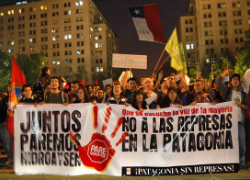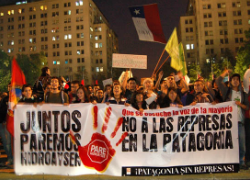
The future of Chile’s Patagonia continues to be a source of steep controversy as a large-scale dam project looms. HidroAysén is the name of the $3.2 billion hydroelectric dam project that appears to be slowly moving forward in the Aysén region of the South American country. If HidroAysén is executed according to current plans, it will be a complex of five dams on two rivers that would flood more than 12,500 acres of pristine Patagonia territory. The Chilean government’s approval of the project last year was promptly challenged by the project’s opponents in the Chilean courts. Recently, the nation’s Supreme Court rejected seven appeals filed objecting to HidroAysén. Since this ruling, the project has continued to advance.
Aside from the environmental impact, HidroAysén is particularly controversial in Chile because the country is having trouble securing enough energy supplies to keep up with its own economic growth. In order to fuel such growth, it is estimated that Chile will need to double its electricity capacity generation over the next 10 to 15 years. HidroAysén would contribute 2,750MW – or 20 percent of the country’s electricity demand – of energy to Chile’s energy system.
The HidroAysén project has been met with a great deal of opposition. Last summer, after the Chilean government announced its initial approval of the project, several massive protests filled the streets of Santiago and the country’s other major cities. The protests resulted in 28 police officer injuries and more than $100,000 in damage to public property. The project has also taken a toll on President Sebastián Piñera’s administration; his approval rating fell to 36 percent in May of 2011, after his administration announced the approval of HidroAysén.
Opponents say that Chile should instead focus its efforts on modernizing current energy sources and on implementing improvements that would make the current system more efficient. Environmental organizations, like Greenpeace Chile, further argue that HidroAysén’s benefits are too small to merit destruction to parts of Patagonia. Opponents are also skeptical of the government’s claims that one of HidroAysén’s primary purposes is to provide poorer Chileans with cheaper energy. Instead they contend HidroAysén is simply a means to provide cheap electricity to the mining industry, which is at the core of Chile’s economic prosperity.
Meanwhile, the Chilean government argues that, in order to meet the country’s growing energy demands, it needs to implement agressive energy alternatives than what is already in place. The government further explains that the project is part of Chile’s goal to reduce its 96 percent dependence on imported oil and give the country more energy independence. The Chilean government defends the need for HidroAysén and projects like it because, while alternative energy, like solar or wind, is more sustainable, such sources are not as reliable or stable as more traditional energy sources. Despite the level of opposition to the project from the public, President Piñera has expressed a great deal of support and praise for the project. Piñera has explained to the press that while he is concerned with protecting the environment, he is more concerned with the health and quality of life of his fellow Chileans.
Chile has been criticized because, compared to Brazil or Argentina, it is doing very little to incentivize renewable energy development and that in five to ten years, solar options that achieve the same goals will be cheaper than it will be to operate and maintain HydroAysén. Opponents say Piñera is showing signs of the kind of corporate-government economic free-market concentration that has defined past Chilean governments and they remain suspicious of the project’s true motives since an Italian-Spanish-Chilean consortium owns HidroAysén, and the majority stakeholder, Endesa Chile, owns most of the water rights to both rivers the dam would affect.
HidroAysén does not expect to have final approval until about 2013. The first dam could be operating by 2019, the last by 2025. After several months of debate, the controversy continues to be an issue of national concern. It is unclear whether the potential HidroAysén project in a place with some of the most dramatic landscapes in the world, when officially approved, will reflect a compromise between the Piñera administration and the Chilean people.
But for now, the biogem that is Patagonia remains safe.
Gaby Corica is a rising third year law student, a member of the Denver Journal of International Law and Policy, and a Senior Editor on The View From Above.


